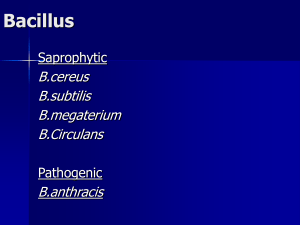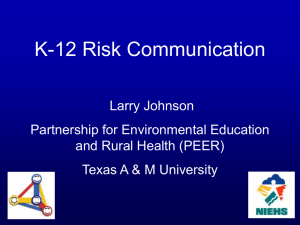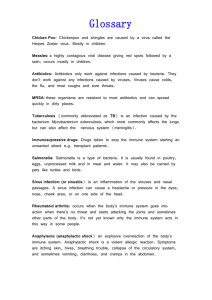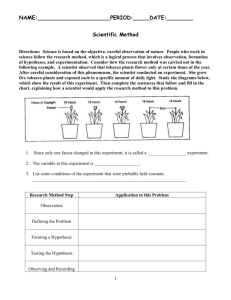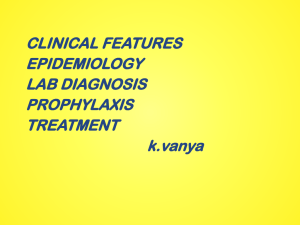Information for Primary Care Clinicians
advertisement
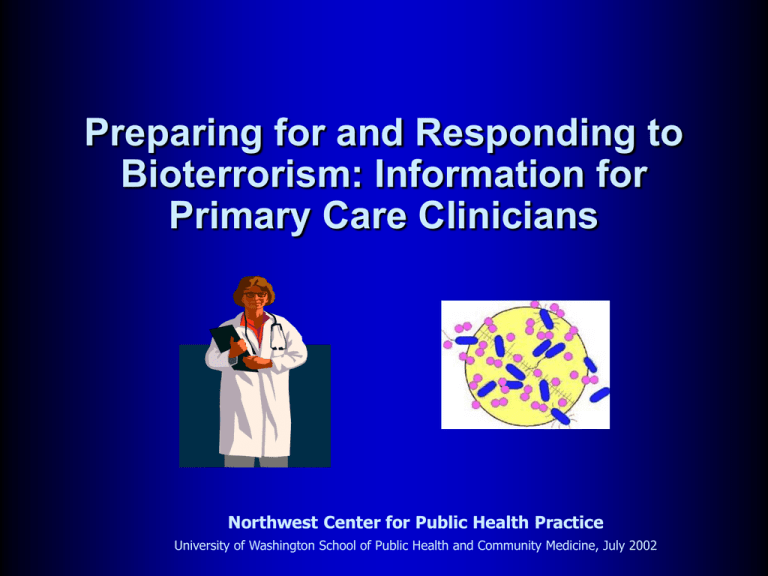
Preparing for and Responding to Bioterrorism: Information for Primary Care Clinicians Northwest Center for Public Health Practice University of Washington School of Public Health and Community Medicine, July 2002 Acknowledgements This presentation, and the accompanying instructor’s manual (current as of 7/02), were prepared by Jennifer Brennan Braden, MD, MPH, at the Northwest Center for Public Health Practice in Seattle, WA, and Jeff Duchin, MD with Public Health – Seattle & King County and the Division of Allergy & Infectious Diseases, University of WA, for the purpose of educating primary care clinicians in relevant aspects of bioterrorism preparedness and response. Instructors are encouraged to freely use all or portions of the material for its intended purpose. The following people and organizations provided information and/or support in the development of this curriculum. A complete list of resources can be found in the accompanying instructor’s guide. Patrick O’Carroll, MD, MPH The Centers for Disease Control and Prevention Project Coordinator Judith Yarrow Health Policy & Analysis, University of WA Design and Editing UW Northwest Center for Public Health Practice Jane Koehler, DVM, MPH Communicable Disease Control, Epidemiology and Immunization section, Public Health - Seattle & King County Ed Walker, MD; University of WA Department of Psychiatry Diseases of Bioterrorist Potential Anthrax CDC, AFIP UW Northwest Center for Public Health Practice Diseases of BT Potential Learning Objectives Be familiar with the agents most likely to be used in a biological weapons attack and the most likely mode of dissemination Know the clinical presentation(s) of the Category A agents and features that may distinguish them from more common diseases Be familiar with diagnosis, treatment recommendations, infection control, and preventive therapy for management of infection with or exposure to Category A agents. UW Northwest Center for Public Health Practice Biological Agents of Highest Concern Category A Agents “Easily disseminated,” infectious via aerosol Susceptible civilian populations Cause high morbidity and mortality Person-to-person transmission Unfamiliar to physicians – difficult to diagnose/treat Cause panic and social disruption Previous development for BW Biological Agents of Highest Concern Category A Agents Variola major (Smallpox) Bacillus anthracis (Anthrax) Yersinia pestis (Plague) Francisella tularensis (Tularemia) Botulinum toxin (Botulism) Filoviruses & Arenaviruses (Viral hemorrhagic fevers) Report ANY suspected illness due to these agents to Public Health immediately. Biological Agents of 2nd Highest Concern Category B Agents Coxiella burnetti (Q-fever) Brucella species (brucellosis) Burkholderia mallei (glanders) Alphaviruses (Venezuelan, Western and Eastern encephalomyelitis viruses) Ricin toxin from Ricinus communis (castor bean) Epsilon toxin from Clostridium perfringens Staphlococcus enterotoxin B Biological Agents of 2nd Highest Concern Food- or Water-borne Category B Agents Salmonella species Shigella dysenteriae Escherichia coli 0157:H7 Vibrio cholera Cryptosporidium parvum Biological Agents of 3rd Highest Concern Category C Agents Emerging pathogens that could be engineered for mass dissemination in the future Nipah virus Hantaviruses Tick-borne hemorrhagic fever viruses Tickborne encephalitis viruses Yellow fever Multidrug-resistant tuberculosis UW Northwest Center for Public Health Practice Anthrax Overview Primarily a disease of herbivores Hardy spore exists in soil reservoir Humans infected naturally by contact with infected animals or contaminated animal products In the early 1900s ~130 cases/yr in U.S. Woolsorter’s disease: inhalation anthrax Until 2001, 18 U.S. cases of inhalation anthrax reported in the 20th century Last naturally occurring U.S. case of inhalation anthrax in 1976 CDC Inhalational Anthrax Acquisition of Infection Infectious dose in humans not precisely known Estimated 8-50,000 spores required for inhalation anthrax May be less in the context of bioterrorism May depend on host factors and bacterial strain Inhalational Anthrax Acquisition of Infection Infectious aerosol particles >5 in size fall from atmosphere and bond to surfaces Secondary aerosolization unlikely Particles 1-5 behave like a gas and are deposited in alveoli No environmental residue Inhalational Anthrax Pathogenesis Once deposited, the inert spores reside within alveoli, potentially for weeks Inhaled spores taken up by alveolar macrophages regional (mediastinal, hilar, peribronchial) lymph nodes Spores germinate, producing vegetative cells that proliferate within macrophages and gain access to the bloodstream Inhalational Anthrax Pathogenesis Vegetative cells produce toxins Lethal factor (LF): protease inhibits protein synthesis tissue necrosis Edema factor (EF): adenylate cyclase extensive edema Protective antigen: combines with LF and EF to produce functional toxins Spores continue to vegetate within host for several weeks Antibiotics can prolong the incubation period by killing the germinating cells while spores remain viable Inhalational Anthrax Clinical Features Incubation period: 1 to 43 days or longer; may be related to dose and host factors Initial symptoms typically appear in 2-5 days Nonspecific: fever, dry cough, chest discomfort, myalgia, malaise, profound fatigue, sweats GI symptoms Late symptoms Hemorrhagic mediastinitis, pleural effusions lead to dyspnea, cyanosis CNS symptoms: hemorrhagic meningitis Toxemia leads to rapid progression to shock, death Inhalational Anthrax Clinical Features No person-to-person transmission of inhalational anthrax Mortality rate 100% despite aggressive Rx in “advanced disease” but is lower with early treatment 6/11 cases in the 2001 outbreak survived with early aggressive therapy BT-Related Inhalational Anthrax Symptoms Symptoms Fever, chills Fatigue, malaise, lethargy Cough (often nonproductive) Nausea or vomiting Dyspnea Sweats, often drenching Chest discomfort or pleuritic pain Myalgias Headache Confusion Abdominal pain Sore throat Rhinorrhea n=10 10 10 9 9 8 7 7 6 5 4 3 2 1 Jernigan, et al. Emerg Infect Dis, NOV 2001 This link will take you away from the educational site BT-Related Inhalational Anthrax CXR & CT Scan Findings CXR Findings n=10 Any abnormality 10/10 Mediastinal widening 7/10 Infiltrates/consolidation 7/10 Pleural effusion 8/10 CT Scan Findings Any abnormality 8/8 Mediastinal lymphadenopathy or widening 7/8 Pleural effusion 8/8 Infiltrates/consolidation 6/8 Jernigan, et al. Emerg Infect Dis, NOV 2001 This link will take you away from the educational site Inhalational Anthrax CXR of Case CDC AFIP BT-Related Inhalational Anthrax CXR of Case Jernigan, et al. Emerg Infect Dis, NOV 2001 BT-Related Inhalational Anthrax Chest CT of Case Jernigan, et al. Emerg Infect Dis, NOV 2001 BT-Related Inhalational Anthrax CXR of Case Jernigan, et al. Emerg Infect Dis, NOV 2001 BT-Related Inhalational Anthrax Chest CT of Case Jernigan, et al. Emerg Infect Dis, NOV 2001 2001 Anthrax Outbreak Outcome Anthrax Letter Cases 22 Anthrax Cases 11 Confirmed inhalational anthrax 11 cutaneous anthrax cases (7 confirmed, 4 suspected) 5 deaths (45% mortality rate) No deaths MMWR Weekly 50(48);1077-9 This link will take you away from the educational site UW Northwest Center for Public Health Practice When to Think Inhalational Anthrax History/Epi Clues Other recent cases of inhalational anthrax (i.e., outbreak occurring) in your community Claims* by a terrorist or aggressor of a release of anthrax in your practice area Illness in persons with common ventilation system or other exposure *a ‘credible threat’ as determined by law enforcement or public health officials UW Northwest Center for Public Health Practice When to Think Inhalational Anthrax History/Epi Clues Cluster of cases with a similar or unusual syndrome consistent with anthrax More severe respiratory disease than expected, or failure to respond to standard therapy Increase in persons with respiratory illness outside of the “flu season” UW Northwest Center for Public Health Practice Bioterrorism-Associated Anthrax Epidemiologic Curve Inhalation Case NYC FL NJ* DC Cases CT 5 4 3 2 NYC letters* Senate letters* 1 0 9/17 9/21 9/25 9/29 *Postmarked date of known contaminated letters. UW Northwest Center for Public Health Practice 10/3 10/7 10/11 10/15 10/19 10/23 10/27 11/14 Date of Onset *10/19 susp cutaneous case later removed Modified from: MMWR Nov 2, 2001; 50(43) This link will take you away from the educational site Differential Diagnosis Anthrax vs. Influenza-Like Illness MMWR. Nov 9, 2001;50(44) UW Northwest Center for Public Health Practice This link will take you away from the educational site Inhalational Anthrax Diagnosis Nondescript prodrome followed by an overwhelming respiratory or systemic illness CXR/CT: widened mediastinum, pleural effusion, infiltrates/consolidation CT scan may show pulmonary abnormalities not seen on CXR Mediastinal/hilar adenopathy with increased density on CT suggests hemorrhagic mediastinitis Blood culture and Gram stain Blood cultures may be positive in initial phase of illness Likely to be negative shortly after initiation of antibiotic therapy Inhalational Anthrax Diagnosis CSF culture and Gram stain if CNS disease present Pleural fluid culture, cytology for immunohistochemistry, biopsy Hemorrhagic fluid, few WBC, high protein No clinically useful test to detect exposure to anthrax Nasal swabs and serology not useful in clinical case management B. anthracis in CSF Jernigan, et al. Emerg Infect Dis, NOV 2001 This link will take you away from the educational site Cutaneous Anthrax Presentation and Course Most common form (95%) under natural conditions Inoculation of spores under skin Incubation: hours - 12 days Pruritic papule vesicle ulcer/painless eschar with edema, may be surrounded by vesicles Regional lymphadenitis Fever, malaise, headache may be present Death 20% untreated; rare if treated CDC Cutaneous Anthrax Clinical Progression CDC Cutaneous Anthrax Clinical Progression Day 5 Day 10-12 Day 7 Day 15 UW Northwest Center for Public Health Practice CDC Cutaneous Anthrax © 2001, Universidad Peruana Cayetano Heredia Cutaneous Anthrax © 2001, Universidad Peruana Cayetano Heredia Cutaneous Anthrax © 2001, Universidad Peruana Cayetano Heredia Cutaneous Anthrax © 2001, Universidad Peruana Cayetano Heredia Cutaneous Anthrax © 2001, Universidad Peruana Cayetano Cutaneous Anthrax Diagnosis Low suspicion Vesicular fluid for Gram stain and culture Synthetic swab of exudate or most actively inflamed area Punch biopsy for Gram stain and culture Specimen in sterile saline High suspicion 2 punch biopsies for culture, PCR and IHC at CDC One sample in formalin for IHC and histopathology One sample at -70C or on dry ice for culture and PCR Blood culture Acute and convalescent sera Anthrax Treatment Antibiotics are effective against germinating or vegetative B. anthracis but not against the spore form Disease development can be prevented as long as therapeutic levels of antibiotics are maintained to kill germinating organisms, or until remaining spores are cleared or controlled by immune defenses (duration unclear) Inhalational Anthrax Treatment Recommendations, 2001 Outbreak Initial IV followed by PO for a total of 60 days Ciprofloxacin Adults 400mg IV q12 hs Children 10-15 mg/kg q12 hs not to exceed 1g/d OR, If susceptible Doxycycline Adults and children >8 yrs & >45kg: 100mg IV q12 hs Children >8 yrs and <45kg: 2.2mg/kg/dose IV q12 hs Children <8 yrs: 2.2mg/kg/dose IV Q 12 hs And 1-2 other antimicrobials (e.g.,clindamycin, rifampin) CDC. Update: Investigation of Bioterrorism-Related Anthrax and Interim Guidelines for Exposure Management and Antimicrobial Therapy, Octonber 2001. MMWR 2001; 50:909 This link will take you away from the educational site Inhalational Anthrax Treatment Supportive care ICU management Drainage of pleural effusions Standard precautions, no need for isolation Cutaneous Anthrax Treatment Cutaneous anthrax without potential aerosol exposure can be treated with 7-10 days of antibiotic therapy In the context of bioterrorism, usually treat for 60 days because of potential aerosol exposure Cover lesions – treat dressings as biohazard waste IV treatment indicated for systemic involvement, extensive edema, or head and neck lesions Anthrax Post-Exposure Prophylaxis (PEP) Oral antibiotics x 60 days Ciprofloxacin Adults: 500mg PO Q 12 hs Children 10-15mg/kg/dose Q 1g/d 12 hs not to exceed If susceptible: Doxycycline Adults and children >8 yrs and >45kg: 100mg PO Q 12 hs Children >8 yrs and <45kg: 2.2mg/kg/dose BID Children <8 yrs: 2.2mg/kg/dose BID Amoxicillin Adults and children >20Kg: Children <20kg: 40mg/kg/d Q 8 hs 500 mg PO Q 8 hs divided in 3 doses MMWR Weekly 50(42) This link will take you away from the educational site Anthrax Post-exposure Prophylaxis Beyond 60 days? Rationale: Viable spores demonstrated in mediastinal lymph nodes of monkeys 100d post-exposure ACIP Recommendations (December, 2000): If anthrax vaccine is available, antibiotics can be discontinued after 3 doses of vaccine (0, 2, and 4 weeks) MMWR 49(RR-15) Link to Webcast UW Northwest Center for Public Health Practice These links will take you away from the educational site Anthrax Extension of PEP: CDC Options Earlier Recommendations – 60 days of antibiotics + medical monitoring Additional Option 1 – 40 additional* days of antibiotic treatment + medical monitoring Additional Option 2 – 40 additional* days of antibiotic treatment + 3 doses of anthrax vaccine over 4 weeks + medical monitoring *Total=100days UW Northwest Center for Public Health Practice CDC Responds, Dec 21, 2001 This link will take you away from the educational site Anthrax Letters Extension of PEP: CDC Options Both additional options investigational PEP approved by FDA for only 60 days Anthrax vaccine, 3-dose schedule and lot number not approved for this particular use Link to Webcast UW Northwest Center for Public Health Practice This link will take you away from the educational site Anthrax Vaccine Current U.S. vaccine (FDA Licensed): culture supernatant (protective antigen) of attenuated, non-encapsulated strain Protective against cutaneous (human data) and possibly inhalational anthrax (animal data) Injections at 0, 2, 4 wks & 6, 12, 18 mos; yearly boosters 3-dose schedule (0, 2, 4 wks) may be effective post-exposure, when given with antibiotics 83% serologic response after 3 doses, 100% after 5 Limited availability Anthrax Vaccine Adverse Effects Safety profile similar to other licensed vaccines Up to 30% with mild discomfort (tenderness, redness, swelling, or itching) at inoculation site for up to 72 hours <2% with more severe local reactions, potentially limiting use of the arm for 1-2 days Systemic reactions uncommon Anthrax Summary of Key Points The most likely presentation of anthrax in a BT attack is inhalational disease; cutaneous disease is also possible. Early in the course of illness, inhalational anthrax is not easily distinguished from an influenza-like illness due to other causes. Symptoms suggestive of inhalational anthrax include a febrile respiratory illness with profound fatigue, drenching sweats, GI involvement, or chest pressure or pain. UW Northwest Center for Public Health Practice Anthrax Summary of Key Points There are no specific chest x-ray findings for inhalational anthrax. CXR is usually abnormal and may demonstrate mediastinal widening/hilar adenopathy, infiltrates/ consolidation, or pleural effusions. CT scan of the chest is a more sensitive test and may show these abnormalities before they appear on CXR. Hyperdense lymphadenopathy on a non-enhanced CT of the chest is suggestive of anthrax. UW Northwest Center for Public Health Practice Anthrax Summary of Key Points Antibiotic prophylaxis and possibly anthrax vaccine can be used to prevent development of disease in infected persons. Anthrax is not transmitted person to person. UW Northwest Center for Public Health Practice Anthrax Case Studies and Reports These links will take you away from the educational site JAMA 286(20) and 287(7) Jernigan et al., Emerging Infect Dis 7(6):933-44 The Sverdlovsk anthrax outbreak of 1979. Science. 1994;266:1202-1208 Roche et al. New Engl J Med 345:1611 Bush et al. New Engl J Med 345:1607-1610 UW Northwest Center for Public Health Practice Summary - Category A Critical Agents Disease Transmit Man to Man Infective Dose* (Aerosol) Incubation Period Duration of Illness Approx. case fatality rate Inhalation anthrax Pneumonic Plague No 8,000-50,000 spores 100-500 organisms 1-6 days 3-5 days (usually fatal if untreated) 1-6 days (usually fatal) High Tularemia No High 2-10 days (average 3-5) 7-17 days (average 12) > 2 weeks Smallpox Viral Hemorrhagic Fevers Moderate 10-50 organisms Assumed low (10-100 organisms) 1-10 organisms 2-21 days Death between 7-16 days Botulism No 0.001 g/kg is LD50 for type A 1-5 days Death in 24-72 hours; lasts months if not lethal High 2-3 days 4 weeks High unless treated within 1224 hours Moderate if untreated High to moderate High for Zaire strain, moderate with Sudan High without respiratory support *infectious dose may be less in certain circumstances Modified from: USAMRIID’s Medical Management of Biological Casualties Handbook UW Northwest Center for Public Health Practice This link will take you away from the educational site Summary Category A Critical Agents Decontamination of exposed persons Showering or washing thoroughly with soap and water adequate for most; bleach not necessary Infection control Standard precautions – all cases Airborne and contact precautions – smallpox and viral hemorrhagic fevers Droplet precautions – pneumonic plague UW Northwest Center for Public Health Practice Resources These links will take you away from the educational site Centers for Disease Control and Prevention Bioterrorism Web page: http://www.bt.cdc.gov/ CDC Office of Health and Safety Information System (personal protective equipment) http://www.cdc.gov/od/ohs/ USAMRIID – includes link to on-line version of Johns Hopkins Center for Civilian Biodefense Studies http://www.hopkins-biodefense.org fact Medical Management of Biological Casualties Handbook http://www.usamriid.army.mil/ sheets and links to other info, including JAMA series from Working Group on Civilian Biodefense and BTrelated anthrax case studies UW Northwest Center for Public Health Practice Resources These links will take you away from the educational site Office of the Surgeon General: Medical Nuclear, Biological and Chemical Information http://www.nbc-med.org St. Louis University Center for the Study of Bioterrorism and Emerging Infections – fact sheets and links http://bioterrorism.slu.edu Public Health - Seattle & King County http://www.metrokc.gov/health UW Northwest Center for Public Health Practice Resources These links will take you away from the educational site American College of Physicians – links to BT resources, including decision support tools and palm documents http://www.acponline.org Self-Assessment (case scenarios – chemical and biological) http://www.acponline.org/bioterro/self_assessment.htm MMWR Rec. and Rep. Case definitions under public health surveillance. 1997;46(RR-10):1-55 UW Northwest Center for Public Health Practice In Case of An Event… Web Sites with Up-to-Date Information and Instructions These links will take you away from the educational site Centers for Disease Control and Prevention http://www.bt.cdc.gov/EmContact/index.asp Saint Louis University, CSB & EI http://bioterrorism.slu.edu/hotline.htm WA State Local Health Departments/Districts http://www.doh.wa.gov/LHJMap/LHJMap.htm Level A Lab Protocols: Presumptive Agent ID http://www.bt.cdc.gov/LabIssues/index.asp UW Northwest Center for Public Health Practice In Case of An Event… Web Sites with Up-to-Date Information and Instructions These links will take you away from the educational site FBI Terrorism Web Page http://www.fbi.gov/terrorism/terrorism.htm WA State Emergency Mgt Division – Hazard Analysis Update http://www.wa.gov/wsem Mail Security http://www.usps.com/news/2001/press/serviceupdates.htm Links to your state health department http://www.astho.org/state.html NIOSH – Worker Safety and Use of PPE http://www.cdc.gov/niosh/emres01.html UW Northwest Center for Public Health Practice


